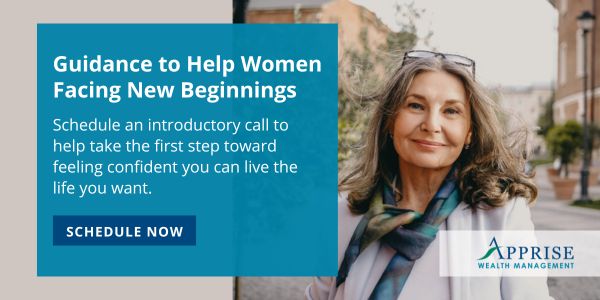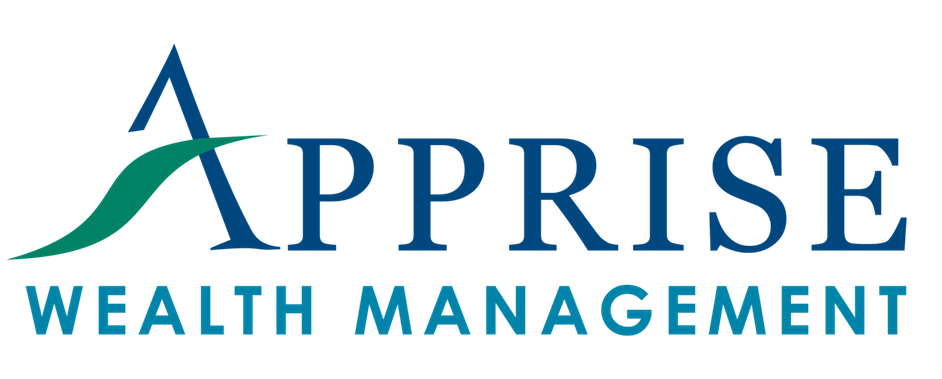WOW, I have asked clients the three Kinder life planning questions since 2020. But Apprise’s life planning process didn’t go much beyond that. As I mentioned in this space several times recently (for example, see here), one of my 2023 goals involves earning the Registered Life Planner® designation. That will allow me to fully integrate the Kinder life-planning process into Apprise’s financial planning process. As a next step toward achieving this goal, from February 15-21, I attended EVOKE Life Planning Training. (E-Exploration; V-Vision; O-Obstacles; K-Knowledge; E-Execution) What a fantastic experience!
Life Planning Training: Reinforcing My Purpose – Part 1
While this multi-part blog – including the other parts that follow – is personal in nature, you should find it instructive. It provides greater insight into what life planning is, what it means to create a life plan, and how that can energize and inspire you. Plus, as an advisor, I ask clients to share with me. It helps me get to know them better. The same applies to me. I should share as well.
Life planning focuses on the human side of financial planning. Life planning helps you reorganize your relationship with money. It allows you to dedicate your financial resources in a way that supports a life of the greatest value, meaning, and purpose to you. It helps you align your spending with what matters most. The goal is to create a practical plan to make your most deeply held life goals happen. Of course, you also create a financial plan that supports your goals. The process should inspire you to do what matters most to you.
Seven Stages of Money Maturity
For me, the three-part journey to becoming a Registered Life Planner® started with the Seven Stages of Money Maturity training course that I took in October. The framework for this course is based on George Kinder’s book of the same name. In the book, Kinder addresses the important role emotions play in our relationship with money and personal finance.
Kinder discusses the seven psychological stages of money maturity. He breaks these down as follows:
Childhood:
- Innocence – A childhood state where money plays no role in our lives.
- Pain – A time when we realize that some have more money than us while others have less. We also learn that life requires us to work.
Adulthood:
- Knowledge – We learn the importance of saving, budgeting, and investing our money.
- Understanding – We come to terms with our emotional feelings related to money; , greed, envy, and resentment.
- Vigor – We discover that physical, emotional, and spiritual energy is required to reach our financial goals.
Awakening:
- Vision – Through our inner wisdom, we try to contribute to the health and well-being of our communities.
- Aloha – We practice compassion and service to others with no expectations of receiving anything in return.
The book – as well as the training are designed to help us uncover the roots of our attitudes about money, and attain true peace, freedom, and security in our financial lives.
When we understand more about why we make financial decisions and can discuss those issues, it becomes easier to make more empowering financial plans. The book and course are designed to help us understand what money is and what role we want it to play in our relationships with ourselves as well as others.
As I’ve written in the past, many of my childhood money memories were far from pleasant. In fact, some were quite painful. Completing the course, reading the book after it, and the questions and memories they asked me to address were painful at times. But completing them also helped me to think about these memories in a different way than I had before. I’ve reconciled with the idea that I can’t change the past, and if things had gone better growing up, I doubt that I would have the family and life that I have today. For that I am truly grateful.
Plus, they reminded me of some things that had long been forgotten. I realized one of these was so important that it’s now part of my life plan. (Sorry, you won’t read about that until later.)
Pursuing the Registered Life Planner® Designation
My experience with Seven Stages convinced me that I wanted to become a Registered Life Planner®. But the question was when. EVOKE was offered in February. Was that too soon? Should I wait until next year? After all, it’s held in Hawaii, not an easy trip. I’d traveled there once before – on my honeymoon – and have always wanted to go back. I asked Diana about joining me, but the logistics weren’t right.
About a month after Seven Stages training I decided to attend EVOKE sooner rather than later. The timing wasn’t great as it meant that I would be away from Diana on Valentine’s Day and apart from my family on my birthday. It might not sound like it, but I decided the timing was right.
Why Now?
In short, I experienced a great awakening that started with the conclusion of Seven Stages Training and my coming down with covid after I returned home. That led to the immediate implementation of some important changes in my life. I removed some things that were distracting me and keeping me from focusing my time on what matters most both personally and professionally. This also led me to read Seven Stages even before we were assigned to do so for EVOKE. This combination of factors left me wondering more about what I want to accomplish and re-examining events from long ago.
Completing EVOKE training and developing my life plan has helped bring greater clarity to what I want to accomplish and better define what matters most to me.
Arriving Early
As you will learn when I share my life plan, I like to travel. But it goes deeper than that. This journey reminded me of how much I enjoy active travel. I want to do and not just see. I want to explore, too. A good friend – that I connected immediately with at Seven Stages training – and I arrived in Maui a couple of days before class started. We stayed in Maui – our training was in Hana.
Diana and I were in Hawaii for our honeymoon. This was my first time back. During our first visit, Diana and I went to the top of Haleakalā Crater (a dormant volcano) to see the sunrise, but we did not hike inside the crater. The plan was for us to bike down (on the road). That worked well for me, but not so much for Diana. She’ll tell you it wasn’t one of my better moments.
This time, my friend and I hiked more than a mile into the crater. Our timing was impeccable as the day was mostly cold and overcast. Fortunately, we got a break in the weather during our hike. The picture you see below was my favorite. I love the colors and the clouds that sit atop the ground. From the top, you don’t realize how vibrant the colors inside the crater can be. This picture reminds me of pictures I’ve seen of Mars. As we made our way out of the crater, we walked through a cloud. We could feel the dampness as we walked through it.

We also explored other areas outside the crater which had lush green vegetation. On Wednesday, we took the famous Road to Hana to get to training – George Kinder hosted the training in his home. Below you see me sitting in front of one of the many waterfalls we stopped to see along the way. There are also a couple of ocean views – check out the water’s deep blue color – and a rainbow eucalyptus tree – notice the bark’s different colors.


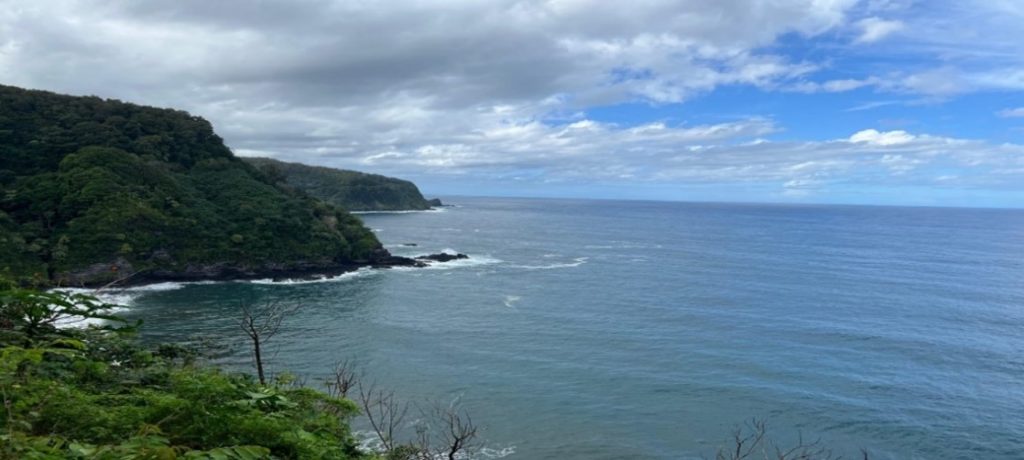

Our journey on the road to Hana took us to the first night of training. This completes the first part of my life planning training experience. If you would like to work together on your life plan, please use this link to schedule a free Strategy Session.
Life Planning Training: Reinforcing My Purpose – Part 2
Training Starts
Life planning training started Wednesday evening. Our exercise for the night was to draw our life maps. I admit it wasn’t my favorite exercise as my artistic ability falls somewhere between non-existent and none. But it was still worthwhile. Of course, much of my life map centered on what I discussed in this blog. It was also great to start to learn more about the other participants and hear their stories.
The next morning several of us arrived early in hopes of seeing the sunrise. Unfortunately, the weather in Hana didn’t cooperate. (Rain and clouds were the standard the whole time we were there.) While it was cloudy that morning, the view was still spectacular. Much to my surprise, while we were there, my friend Megan asked if I’d done my daily back exercises that morning. (I complete this 12-minute YouTube video at least five times a week. It’s helped tremendously.) I said I hadn’t. The next thing you know, the video was on her phone. Two others joined us. Below is our view while doing the exercises. To me, it made for a special moment. Thanks, Megan.

Experiential Training
EVOKE training is experiential. No role-playing. If you want to get the most out of it, you must be your true self. Life planning can be an emotional experience and can lead to tears (it did for me at one point and for my life planning partner at another). But it also allows you to explore your innermost thoughts and feelings and delve into what matters most to you.
As it did every day, the morning started with a 20-minute meditation as well as a related discussion led by George Kinder. I have often heard of the benefits of meditation but haven’t had much success adopting a regular practice in the past. But this experience was different, and for the first time I experienced some of the benefits. I’m now working to incorporate meditation into my daily routine.
During the first morning of training, we picked our life planning partner. I was fortunate enough to pair up with Sherise. Her husband completed the same training a few years ago. She is not an experienced financial planner, but that didn’t matter in the least. She was awesome to work with and did a great job. I expect her to join the same mentorship program that I have already registered for. That will make it easier for us to continue to work together and help each other realize our respective life plans.
The Exploration Meeting
The EVOKE process starts with the exploration meeting. During this meeting, an advisor largely gives their client (or prospective client) the opportunity to speak about what matters to them. The advisor’s role is to listen and provide space. You don’t make judgments. You make it the client’s meeting and not yours. The less you talk the better. You shouldn’t provide advice along the way. Doing so ends the conversation.
The Vision Meeting
If you decide you want to work with a life planner, you receive a series of inspirational exercises to complete after the exploration meeting. These include the three Kinder life planning questions as well as the Heart’s Core Grid (this podcast transcript includes a description). These exercises are discussed during the vision meeting. Later in the process, clients are also asked to complete schedules depicting their Ideal Day, Week, and Year. I prefer to give the three questions to the client before the vision meeting so they can answer them on their own. That allows for a fuller discussion about them at the next meeting. Each attendee had to complete these exercises before class.
As an advisor, I ask clients to share their responses to the three questions. While I’m modified a couple of very personal responses related to some issues one of my children must navigate, I would like to share the questions and my answers – with some minor edits – below. My answers are in bullet format. You can also answer in a narrative format. That’s how Sherise formatted her answers.
Creating Your Life Plan: Vision – Question One
Imagine that you are financially secure and that you have all the money you need for the rest of your life. How would you live your life? Would you change anything? What would you do?
Let yourself go. Don’t hold back on your dreams. Will you change your life and how will you do it?
- Time outside every day – weather permitting – walking, biking, hiking, disc golfing (with kids only).
- Travel at least once a quarter or less frequently but with longer stays. I want to do and not just see things when I travel.
- Time with family and friends.
- Continue working as long as I enjoy it, and it doesn’t interfere with gaining and sharing new experiences.
- Create a foundation or another charitable vehicle that provides private scholarships/financial support for women who go back to school after starting a family. This would be in honor of my mother.
- Develop a program for furthering financial education, especially for teens and young adults.
- After the kids are done with school, have a home base someplace warm – and ideally near an ocean or mountains – that’s relatively near to where our kids settle.
- Read – and learn – even more.
- Elevate my diet.
- See a game in every baseball stadium.
- See Duke play in Cameron Indoor Stadium at least once a year.
- Write a book.
- Help our children as much as possible so they can have happy, successful lives and overcome any difficulties they may face.
- Position our children for success.
- Continue to make sure that dogs are always living in my home.
- Further education – how about a graduate degree from Duke?!!
- Add the CFP, PFS, and RLP designations.
- More one-on-one trips with my kids.
Creating Your Life Plan: Vision – Question Two
This time you visit your doctor who tells you that you have only 5 – 10 years left to live. The good news is that you won’t ever feel sick. The bad news is that you will have no notice of the moment of your death. What will you do in the years you have remaining?
Will you change your life and how will you do it?
- Continue working but start combining work and travel sooner.
- Take more walks and go on more hikes and bike rides than I do now.
- Maximize time with family and friends and make sure they know how much I care for them.
- Depending on where Sarah goes to school, sell our house and move sooner.
- Independent time with each of my kids.
- Make sure my wife and kids are taken care of after I’m gone.
- Have something in place to recognize my mom.
- Stop working sooner if the right steps are in place and Sarah is done with school.
- Work fewer hours.
- At least one Duke game in Cameron with my family.
- Help our children as much as possible so they can have happy, successful lives and overcome any difficulties they may face.
- Position our children for success.
Creating Your Life Plan: Vision – Question Three
This time your doctor shocks you with the news that you have only one day left to live. Notice what feelings arise as you confront your very real mortality. Reflecting on your life, on all your accomplishments as well as on all the things that will remain undone, ask yourself:
What did I miss?
Who did I not get to be?
What did I not get to do?
- Not getting to see any of my kids get married.
- Not being a grandfather.
- Not growing old with my wife.
- Not experiencing other lands and cultures through sustained travel.
- Not helping as many clients as I’d hoped to achieve their goals and dreams.
- Not getting to live someplace warm, new, and different.
- Not helping (or not seeing if he/she can do it on his/her own) our children as much as possible so they can have happy, successful lives and overcome any difficulties they may face.
- Not creating a scholarship/ongoing financial support to help women who went back to school later in life.
- Not doing enough to further financial education, especially for teens and young adults.
When the weather allowed it, some of us ate meals under this spectacular banyan tree on George’s property. Our group completed some of our training exercises under it as well.
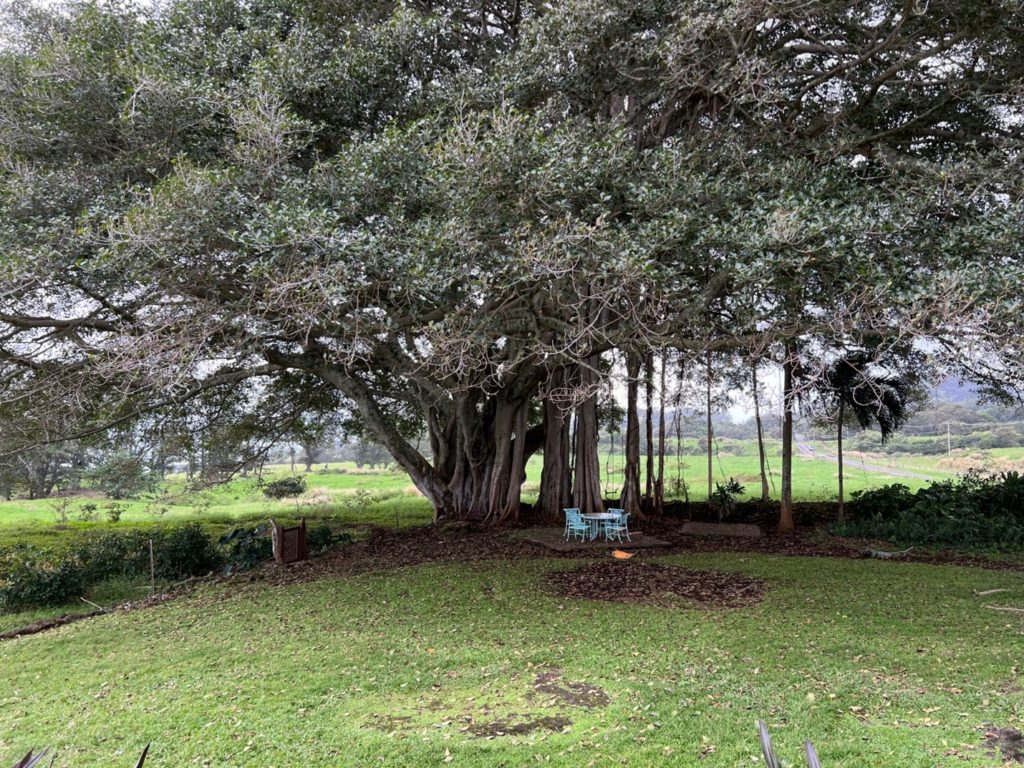
What Do You Do With This Information?
During the vision meeting, you discuss your responses, focusing on the third question. While the others matter too, the third question provides the greatest insights into what matters most to you.
The goal of this exercise is for your advisor to help you create a vision statement. This process is also referred to as “lighting the torch.” Advisors do this to inspire their clients to live their desired lives and to do or accomplish things that truly matter to them. I will say that, in my case, many of the items in my answer to the third question I can’t do anything about. If I was gone tomorrow, I would not be able to achieve those items that represent life milestones. I can take solace in knowing that I always try the best I can to be a good husband, father, parent, and friend as well as a good advisor for my clients.
Creating a vision for our life plans completed the second part of my life planning training experience. If you would like to work together on your life plan, please use this link to schedule a free Strategy Session.
Life Planning Training: Reinforcing My Purpose – Part 3
What Comes After the Vision Meeting?
After vision comes obstacles. During this meeting, we look at what could possibly get in the way of you living your life to the fullest. We help you identify any obstacles and ask more questions to help you determine how you can tackle them head on, which can help you to overcome these obstacles.
The overriding purpose of these exercises is to determine what it is that you want in your life that you have not been able to deliver to yourself.
The Knowledge Meeting
We didn’t spend much time on the knowledge meeting during training. This meeting helps connect your money with your financial life plan. It helps to better align your money with your life. This meeting also includes your Goals for Life and the steps you can take immediately to reach them.
Execution
Once your financial life plan is in place, it’s time to act! With the energy and inspiration generated by the creation of your life plan/ideal life, the advisor and client work together to help you bring your vision to life as quickly as possible.
At this point, an advisor serves as a client’s guide. Your advisor checks in on your progress and can help you if you go off course or something changes.
Presentation of My Life Plan
At the end of the program, each of us had to present our life plan to the rest of the group. We were also asked to summarize our plan in two words. I chose “giving back.”
The areas I focused on for my vision statement related to the following:
- Not creating a scholarship/ongoing financial support to help women who went back to school later in life.
- Not doing enough to further financial education, especially for teens and young adults.
- Not experiencing enough other lands and cultures through sustained active travel.
- Doing everything I can to help each of our four children live happy, healthy lives. Even better would be seeing them do it on their own without any help. Without going into any details, this is more problematic for one of our children than the others.
Why Did I Choose These Items as the Key Elements of My Life Plan?
1. A Scholarship to Help Other Women
In my blog ”Confessions of a Financial Advisor,” I discussed the financial difficulties my family faced growing up. I also talked about how my mother was diagnosed with Stage 4 breast cancer at 51 and passed away when she was only 53 after her cancer metastasized to her brain.
My mother went back to school in her 40s and became an occupational therapist. She then started her own business, specializing as a hand therapist. She was good at what she did and on her way to building a successful business. In my heart, I know that her cancer progressed as far as it did before detection because she was trying to put herself in a position to survive – and thrive – on her own. After all, my father’s poor handling – to put it mildly – of my family’s finances was the driver of my family’s financial difficulties. While I have some ideas from discussions we had, I can only imagine how much pain and anguish this caused my mother.
After my mother passed, I requested that others who cared to make donations to the New Jersey Occupational Therapy Association (NJOTA) instead of making a donation benefiting cancer research. My goal was to create a small scholarship in my mother’s honor. This would help others remember her. It would also support other women who needed help. The effort did not go as planned, and the idea faded from view. I had not given it further thought for years. But the preparation I did for EVOKE training reminded me of this wish and made me want to revive it.
The “why” behind my focus on working with women relates to the struggles my mother went through. As my financial advisory business has evolved, I have committed to focusing the majority of my time, energy, and practice on creating an environment where women could learn about investing, have fun, and become more confident in making smart financial decisions with less stress and worry.
The work I did with Sherise helped me realize that I want to do even more. I want to create an annual scholarship for women who go back to school later in life. In this way, I can give back. I will contact Kean University in New Jersey – my mother graduated from there. The second organization I will contact is the NJOTA – my mother was a member. I plan to start a scholarship that grows over time through one of these organizations that will help other women who – like my mom – return to school later in life.
2. Teach a Class or Course to Further Financial Education, Especially for Teens and/or Young Adults.
I was very intentional in choosing the name Apprise for my business. (You can find a more detailed explanation in the FAQ towards the bottom of Apprise’s home page.) Apprise means to inform or tell someone. I believe that education about financial matters in the U.S. is substandard. I want to do what I can to help bridge that gap.
When my children were younger, I could often be found on the sidelines coaching my kids’ teams – sometimes in rec leagues, and others in travel programs. I regularly coached baseball, soccer, and basketball. I even tried my hand at lacrosse once – and only once. (That’s a story for a different day.)
I like working with and coaching others. I’m going to contact the high school all my kids have attended – my daughter is currently a junior. If I don’t get anywhere by doing that, I will talk to the county school system. After that, the next step would be contacting a local college. I will also continue to offer educational workshops through Apprise.
3. Ongoing, active travel
I changed this one a little from what I originally wrote. We travel regularly. The trip to Hawaii for EVOKE is not this year’s only planned trip. Importantly, my time in Hawaii reminded me that I want to do more than just travel. I want to do things and not just see things. This further reinforced the feeling I had when my son Daniel and I experienced San Francisco – mostly by bike and foot – last March. I had a similar feeling when I was in Seattle with two of my sons last June.
For example, in the “fun to do” column on my Heart’s Core Grid, I wrote that I want to hike to the bottom of the Grand Canyon. I’ve been there twice. The first time was with my parents. We hiked a mile or two down into the canyon. The second time was with my family. We did not hike inside at all. Hiking into Haleakalā Crater reminded me of the beauty and different perspective you see when you get more than just the view from the top.
After class ended, we had time before we had to get back to Maui for the flight home. We hiked a trail along the cliffs to see the red sand beach that you see pictured below. For me, hiking down to the beach and putting my feet in the water was so much better than just seeing the view from above. We also saw the rapidly flowing Venus Pools. The last picture is me with Megan and Sherise at the Venus Pools. Note that when the waters are calmer, you can find people cliff diving near that point. The heavy rains we had that week ruled out that possibility.

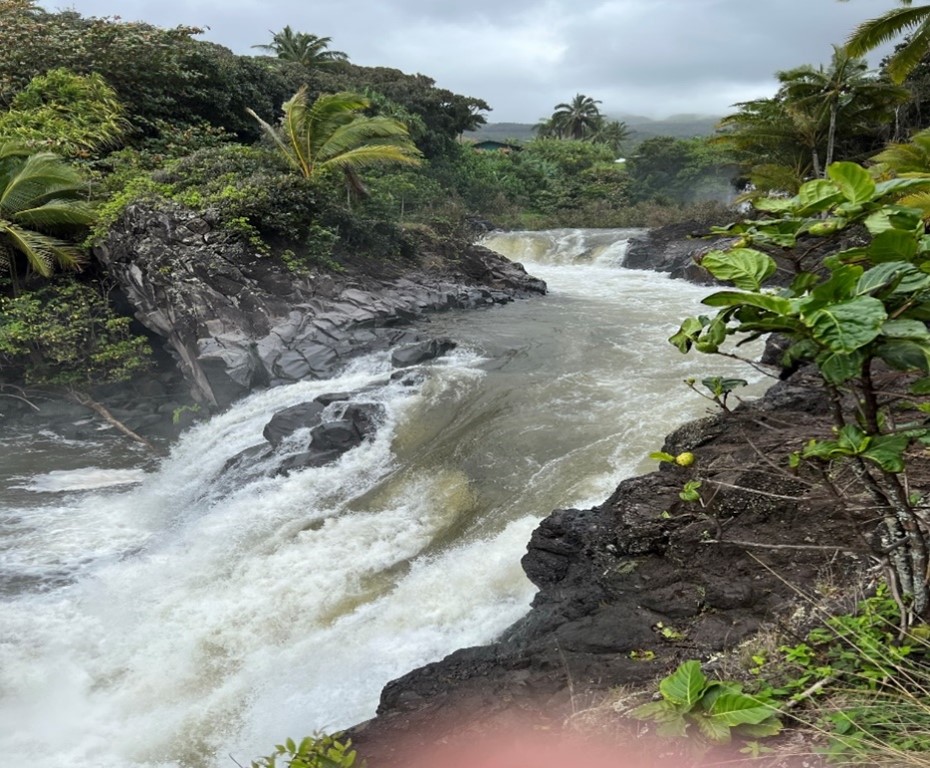

4. Helping My Children Live Happy, Successful Lives
This is the hardest one of all. It’s also the one I will say the least about as I want to protect my children’s privacy. One of our children is struggling to find their place. This is incredibly hard to witness as a parent. I said earlier that at one time during the discussion about my life plan I was brought to tears. The idea that this problem would go away did that. The tears were a mixture of joy – trying to envision a time in the future when things were better – and sorrow. I know I have the least amount of control over this. As a result, my commitment here is to make sure to regularly check in on my children – especially the one who’s struggling – and see how they’re doing at least once a week. While improvement may not happen, I will always keep trying and hoping.
Creating a Vision Statement
In the end, life planners work with their clients to create a vision for the future. The vision is associated with a specific time/date. You could even call this painting a picture. This picture should be something you – as the client – can imagine happening. It should leave you inspired. This vision represents your life plan. It can change with time. You achieve some things. You replace them with others. The process is not one-and-done. You should update it periodically. During training, two of the trainers were paired with other trainees in the life planning exercises. Attendees helped them create their life plans as well. Those life plans were different than what was in their previous life plans.
The trainers participated because one of the original attendees tested positive for COVID before training started. Then another attendee tested positive after arriving. Fortunately, those that spent the most time with this individual – including me – did not get COVID. It ended up working out well for the four of us, as we got to work more closely with these two trainers than we would have as part of the larger group.
Final Thoughts About Creating a Financial Life Plan.
I hope you find the above discussion about creating a financial life plan helpful. If you are a client and would like to work together on your life plan, please email me or schedule a call. I look forward to the opportunity to go through the life planning process with you and will send you the inspirational exercises to get you started.
If you are not a client but would like to work together on your plan, please schedule a free call. I’ll gladly answer any questions and assist in whatever way I can.
Please feel free to check in on me in the future. I don’t want what I’ve written to merely be words on a page. I want to follow through and realize these goals. I’m also looking forward to the mentorship I need to complete to earn the Registered Life Planner® designation. It starts in April.
Thank You!
I would also like to thank my fellow trainees: Jonny, Anne, Bryan, Matt, Miranda, Greta, Ryan, and Katy as well as our trainers: George, Louie, Thom, Brad, Anita, and Kathy. A special thanks to Megan, Sherise, and Wilson with whom I shared a house/apartment and several bottles of red wine. I look forward to our continued friendship. It was a pleasure meeting all of you. I look forward to remaining in touch and going through the upcoming mentorship program with you. I consider myself fortunate to have met all of you.
I’ll be back next week with “Apprise’s Five Favorite Reads of the Week.”
Our practice continues to benefit from referrals from our clients and friends. Thank you for your trust and confidence.
We hope you find the above post valuable. If you would like to talk to us about financial topics including your investments, creating a financial plan, saving for college, or saving for retirement, please complete our contact form. We will be in touch. You can also schedule a call or a virtual meeting via Zoom.
Follow us: Twitter Facebook LinkedIn
Please note. We post information about articles we think can help you make better money-related decisions on LinkedIn, Facebook, and Twitter.
For firm disclosures, see here: https://apprisewealth.com/disclosures/

